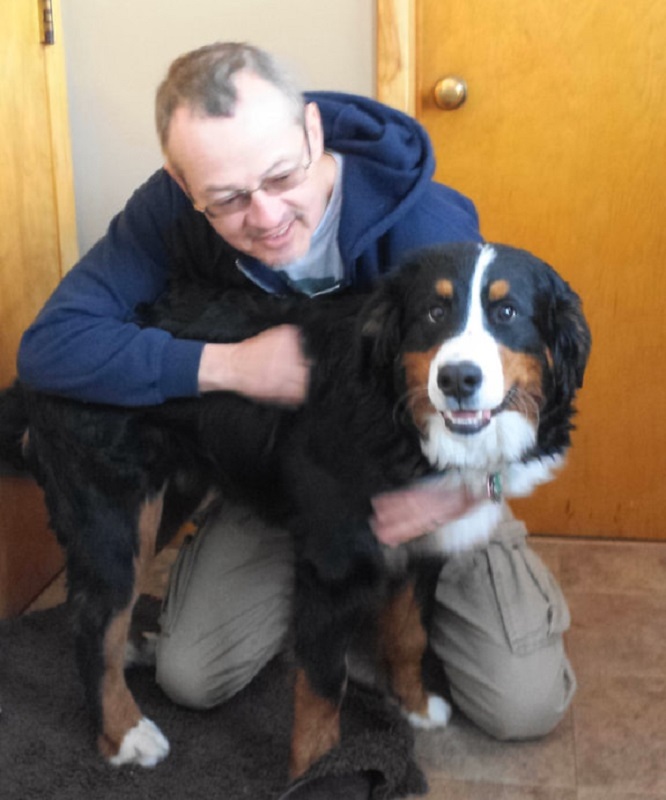Pets and Their People Blog
Not All Dogs Make Good Butlers…Management and Training Can Help
Many of my clients have concerns about how their dogs greet visitors at their home. This article addresses what to do if you have a dog who is not a good butler.
There are 80-90 million dogs living in the USA, and I suspect many are allowed to freely engage with visitors at the front door. That engagement may be with an open mouth barely containing a tongue, a wiggly wagging tail, perhaps with a favorite toy in the dog’s mouth. My dog, Bruno, meets every visitor that way. First, an excited bark, then running off to find a toy to offer to the visitor. He did that very thing today when two men came to service our air conditioner. Bruno is a good butler.
This video demonstrates Bruno’s friendly greeting at the door:
But there is something I have seen more often.
I see the fear – a dog with muscle tension in their body, stiff at first, and then convulsive movements when they bark at the novel person approaching the home, growling (which is often not registered with family members) and then perhaps freezing when the visitor is at the door, followed by a tightly closed mouth and a sudden outburst of barking, lunging and more growling. Nipping and biting may follow. I have seen some dogs display all 42 of their teeth with spittle flying all about, while family members looked on passively as if that was normal behavior.
Sometimes the dog snaps at the intruder, and the family declares, “My dog has never bitten” to which I add, “Yet.”
Dogs who are in a state of high arousal and are triggered by fear, are far more likely to bite than those who see the approach of a visitor as an opportunity for play and fun. Fearful anticipation and happy anticipation are at opposite ends of the emotional spectrum.
Management – Prevent Unwanted Behavior
If alarm, dread and fear are what you see with your dog, then I propose that he/she is a poor butler. Fire them. Give them a different job to do and make that fun and rewarding!
The first step is to prevent the rehearsal of unwanted behavior.
Each time a dog repeats a pattern of behavior, that behavior grows stronger and more resistant to change. Think about how hard it is for you to change a habit and form a new behavior…such as to stop smoking.
For some dogs, simply placing them in a room with the door shut will avoid problems. Give them something to happily entertain themselves when visitors arrive until they calm down. Such things could be food-stuffed toys like KONG, KONG Wobbler ™, a treat-dispensing toy, a licking mat or a snuffle mat. Calming music in the room can help, such as soft classical or meditation music, or an iCalmPet™ device. ADAPTIL® pheromone can also add to the relaxation of the environment.
Training – Create a New Habit
For other dogs, giving them a different job entails creating a new, more appropriate habit. One simple way to help a poor butler develop a new behavior pattern is to teach them a knock on the door, or the sound of the doorbell, is a cue to go to a location where a treat is guaranteed to appear.
You can teach cues such as “Go to Bed” (see Additional Resource) or “Crate” or “Find It” and your dog will trot off to that location to receive or find their treat. If you pair that cue with the front-door stimuli (the knock or doorbell), that is half the battle; a knock on the door means move away from the door and wait for/find your reward.
Video: In response to the doorbell, watch Romeo practice an alternative behavior which is then reinforced generously:
Working Together
Several years ago, I worked with a 100-pound Labrador who spent six years perching at the picture window, waiting for things to pass by the house as he barked and lunged at the perceived threat. A visitor was greeted at the door with the owner struggling to hold the dog back, beckoning the visitor to enter a long, narrow hallway. That is how I first met the dog, and he was not a good butler.
So, he was fired from his butler job and given another…dog bed warmer.
To quicken the learning process, the family prevented their dog from practicing the window-alarm response behavior (management) until they were ready to work with him (training).

Beth Macdonald on Unsplash)
We gave him a bed to go to, far from the window, redirecting him away from the window and towards the bed, where treats were guaranteed to appear. We rewarded waiting there for a release cue, rather than repeating the window-alarm response.
In a few weeks, he stopped perching at the window, waiting for things to bark at, and automatically went to his bed to await his treats when people came to the door.
The process was enhanced by adding an ADAPTIL diffuser to an electrical outlet by his bed, spraying ADAPTIL on his bed, and using an iCalmDog (now sold as iCalmPet™) music player to help calm him. These products have been shown in studies to have a calming effect on dogs. Tasty high value bits of food, tossed onto the bed, added frosting to the cake.
I played the role of visitor while the family practiced redirecting their dog to his reward location and waiting there until I entered, so we could rehearse the new behavior pattern. Their dog became proficient in this new role and paid more attention to family members than to me.
This routine worked, as well, with people passing by the home, and with the dreaded postal worker who appeared on a daily basis at the front door.
The piece de resistance was when a visitor from a foreign country, who was afraid of dogs, came to stay at the home. The retired Labrador butler performed his new role, the visitor felt safe, and international peace was established.
Sometimes, what we need to do is change environmental settings and teach a dog alternative behavior options and then reinforce them generously.
Dogs just do whatever works for them, so let’s work together as a force-free team.

About the Author
Daniel H. Antolec, PCT-A, CCBC-KA, CPDT-KA began teaching dogs in 2011 and founded Happy Buddha Dog Training. He teaches dogs in a way that makes it fun for pet stewards and pets alike.
Additional Resource
Video Demonstration – Bruno demonstrates Go to Bed

